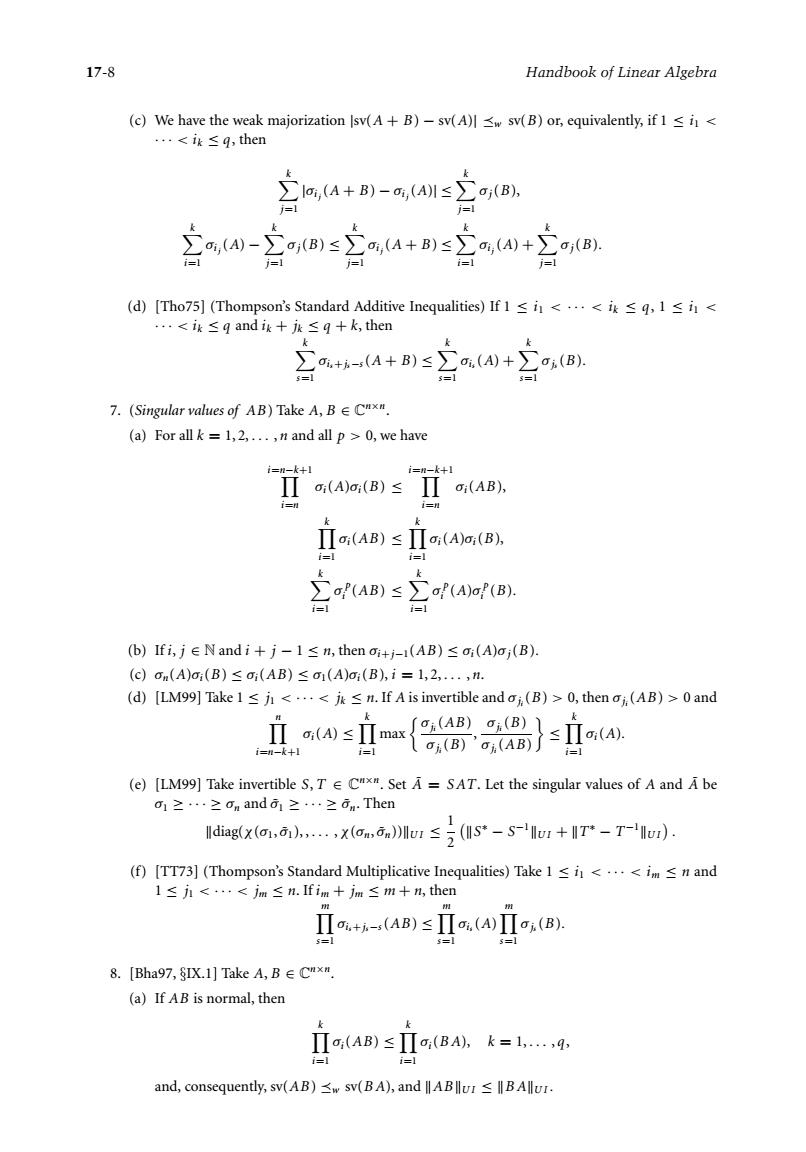正在加载图片...

17-8 Handbook of Linear Algebra (c)We have the weak majorization Isv(A+B)-sv(A)sv(B)or,equivalently,if 1i< <ik≤q,then ∑,(A+B)-,(A1s∑,B, 1= = 2a++≤2aW+2o, =1 s=l 7.(Singular values of AB)Take A,BCx". (a)For allk =1,2,...,n and all p >0,we have ”aAa8)≤7”aA8. i,(AB)≤Πa,(Aa(B), (b)Ifi,j ENandi+j-1s n,then +j-(AB)<a:(A)a;(B). (can(A)a(B)<a:(AB)<a1(A)a(B)、i=1.2,...,n. (d)LM99 ]Take 1≤i< .<n.If A is invertible and (B)>0,then (AB)>0and io(A)≤Πmax{。 「O(AB)O(B)1 k+ .≥and d≥…≥i.Then lldiag(x(n1)....x(am))ur s(S*-S-u+-T-v) (0【TT73)](Thompson'sStandard Multiplicative Inequalities))Take 1≤i<…<iw≤nand 1≤<…<jm≤.lfim+jm≤m+n,then Ⅱ+h-uB)≤Ⅱw,(8 8.[Bha97,X.1]Take A,B C"x" (a)If AB is normal,then Ⅱ(AB)≤Ⅱ,(BA,k=19, and,consequently,sv(AB)sv(BA),and ABBAllUr17-8 Handbook of Linear Algebra (c) We have the weak majorization |sv(A + B) − sv(A)|
w sv(B) or, equivalently, if 1 ≤ i1 < ··· < ik ≤ q, then k j=1 |σi j(A + B) − σi j(A)| ≤ k j=1 σj(B), k i=1 σi j(A) − k j=1 σj(B) ≤ k j=1 σi j(A + B) ≤ k i=1 σi j(A) + k j=1 σj(B). (d) [Tho75] (Thompson’s Standard Additive Inequalities) If 1 ≤ i1 < ··· < ik ≤ q, 1 ≤ i1 < ··· < ik ≤ q and ik + jk ≤ q + k, then k s=1 σis + js −s(A + B) ≤ k s=1 σis(A) + k s=1 σjs(B). 7. (Singular values of AB) Take A, B ∈ Cn×n. (a) For all k = 1, 2, ... , n and all p > 0, we have i=n −k+1 i=n σi(A)σi(B) ≤ i=n −k+1 i=n σi(AB), k i=1 σi(AB) ≤ k i=1 σi(A)σi(B), k i=1 σ p i (AB) ≤ k i=1 σ p i (A)σ p i (B). (b) If i, j ∈ N and i + j − 1 ≤ n, then σi+ j−1(AB) ≤ σi(A)σj(B). (c) σn(A)σi(B) ≤ σi(AB) ≤ σ1(A)σi(B), i = 1, 2, ... , n. (d) [LM99] Take 1 ≤ j1 < ··· < jk ≤ n. If A is invertible and σji(B) > 0, then σji(AB) > 0 and n i=n−k+1 σi(A) ≤ k i=1 max σji(AB) σji(B) , σji(B) σji(AB) ≤ k i=1 σi(A). (e) [LM99] Take invertible S, T ∈ Cn×n. Set A˜ = S AT. Let the singular values of A and A˜ be σ1 ≥···≥ σn and σ˜1 ≥···≥ σ˜n. Then diag(χ(σ1, σ˜1), , ... , χ(σn, σ˜n))U I ≤ 1 2 S∗ − S−1 U I + T∗ − T−1 U I . (f) [TT73] (Thompson’s Standard Multiplicative Inequalities) Take 1 ≤ i1 < ··· < im ≤ n and 1 ≤ j1 < ··· < jm ≤ n. If im + jm ≤ m + n, then m s=1 σis + js −s(AB) ≤ m s=1 σis(A) m s=1 σjs(B). 8. [Bha97, §IX.1] Take A, B ∈ Cn×n. (a) If AB is normal, then k i=1 σi(AB) ≤ k i=1 σi(B A), k = 1, ... , q, and, consequently, sv(AB)
w sv(B A), and ABU I ≤ B AU I .������������